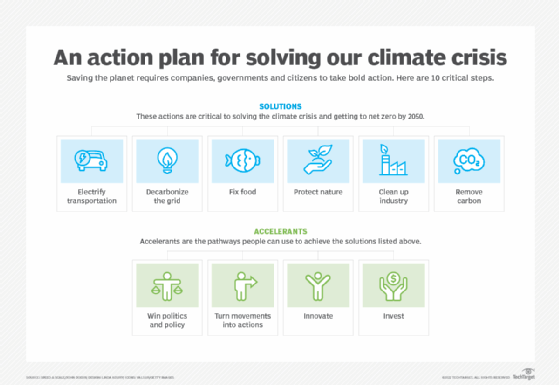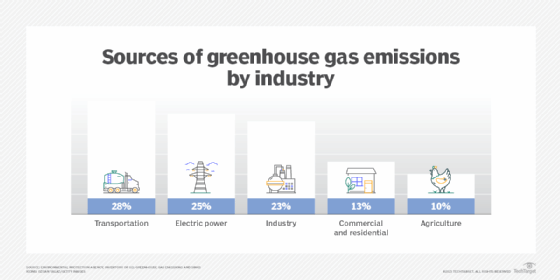net zero
What is net zero?
Net zero refers to a state in which all human-caused greenhouse gas (GHG) emissions are counterbalanced so humanity no longer adds carbon to the atmosphere. To achieve net zero, a company must identify all the emissions it is responsible for creating and then reduce them as much as possible by investing in projects that prevent emissions elsewhere or remove carbon from the atmosphere.
There needs to be a perfect balance between adding and removing GHG emissions. For example, emissions can be removed through carbon sinks such as forests and oceans that remove more carbon from the air than they add.
Net zero is formally defined in the Corporate Net-Zero Standard from Science-Based Targets (SBTi). The standard states companies must abate 90% of emissions and reduce 10% through permanent removals.
The importance of global net-zero emissions by 2050
Humanity needs to get to global net-zero emissions by 2050 to preserve a livable planet, according to the United Nations (U.N.).
The Paris Agreement states that the global temperature increase needs to be limited to 1.5 degrees Celsius above pre-industrial levels. The planet is currently 1.1 degrees Celsius above pre-industrial levels. To stay below 1.5 degrees Celsius, emissions need to be reduced by 45% by 2030 and reach net zero by 2050.
Countries, cities and businesses are working together to achieve global net zero by 2050. At the time of this writing, however, national plans are not on track to reduce GHG emissions by 45% by 2030. Instead, GHG emissions are expected to increase by 10%, according to an October 2022 United Nations Climate Change report.

Differences between net zero, carbon neutral and gross zero
The terms net zero, carbon neutral and gross zero are often used interchangeably, but there are subtle differences.
Net zero generally refers to all GHG emissions, including carbon dioxide, methane and sulfur dioxide. Greenhouse gas emissions of all kinds are expressed in tons of carbon dioxide equivalent (CO2e). SBTi validates net-zero targets under its corporate standard.
Carbon neutral generally refers to the neutralization of only carbon dioxide. The SBTi does not validate carbon neutrality. The term carbon neutral is often used by businesses to signal their intent to use carbon offsets to neutralize their existing emissions.
However, using a carbon offset does not guarantee the company reduced emissions to reach net zero. Exaggerating progress toward net zero or carbon neutrality is a form of Greenwashing. There is a worry that companies will use carbon offsetting to avoid reducing their own emissions in the future.
The timeframe to reach zero carbon emissions is different than the one to attain net zero for all greenhouse gases, such as methane and nitrous oxide. Emissions neutrality often focuses on carbon dioxide since it is the most abundant of the greenhouse gases and the most dangerous.
Gross zero is when GHG emissions from all sources are reduced to zero. Some companies in the energy sector aim to achieve gross zero.
What is a net-zero target and why is it important?
Net-zero targets are the goals companies, governments and other organizations set in pursuit of global net zero. These targets usually consist of a date to reach net zero and the incremental steps to get there. The Paris Agreement has countries submit climate plans, known as nationally determined contributions (NDCs), every five years to help align near- and long-term emissions reduction goals. Many countries set their long-term net-zero targets for 2050.
Countries may contribute to net-zero goals by investing in green infrastructure, sustainable policies and pressuring the private sector to invest in climate action.
Corporations can use the SBTi Corporate Net-Zero Standard to set net-zero targets that are in line with the goals of the Paris Agreement. Companies submit a letter of commitment to a target to the SBTi, develop that target in line with SBTi's criteria and then present the target to the SBTi to be validated. After validating the target with SBTi, the company can communicate the target to stakeholders and track annual progress.
Six tips for organizations transitioning to net-zero emissions
Achieving net zero is a complex feat and looks different for every company. In addition to guidance from the Environmental Protection Agency (EPA), organizations can use the following tips to approach their net-zero transition.
1. Set scientifically rooted and motivated targets
Companies should set science-based goals that are in line with the latest climate science to meet the Paris Agreement goals.
2. Set short- and long-term targets
Companies need to set short-term goals to reach the long-term goals of halving emissions by 2030 and achieving net zero by 2050. Near-term targets generally span five years to 10-years.
3. Have clear accountability and responsibilities
There should be built-in mechanisms to hold companies accountable to net-zero goals. Companies should have a viable, concrete and achievable plan with a team and timeline. Achieving both short- and long-term goals requires tangible steps and integration with the core business strategy.
4. Invest in sustainable technology
Although it can be more expensive, it is important to invest in sustainable technology to put the company on a trajectory to reach long-term net-zero goals. Use metrics that improve IT choices. Invest in technology where the biggest improvements can be made. For many organizations, that's Scope 3 emissions, which are produced by suppliers and partners.
5. Avoid greenwashing
Companies may need offsets to achieve climate goals where emissions reduction is not possible. Overusing or misusing offsets to replace viable reduction opportunities is a form of greenwashing.
6. Use sustainability management software
Sustainability management software can help companies track progress toward net zero by automating emissions measurement and providing support for environmental, social and governance reporting frameworks.
Net-zero frameworks and resources
The SBTi Corporate Net-Zero Standard provides an official definition of net zero for corporations. There are many other frameworks and resources that businesses can use to guide progress toward net zero, including the following:
- Carbon Disclosure Project self-reporting tool. CDP is a voluntary self-reporting framework for disclosing environmental information to company stakeholders.
- Net Zero Investment Framework. The framework is provided by the Institutional Investors Group on Climate Change and is used by investors to decarbonize investment portfolios and increase investment in net-zero targets.
- Partnership for Carbon Accounting Financials. PCAF helps organizations account for their financed emissions using its Global GHG Accounting and Reporting Standard for the financial industry.
- Taskforce on Climate-related Financial Disclosures. The TCFD seeks to provide accurate information about climate-related risks to investors.
- Transition Pathway Initiative. The TPI provides an open access analytical tool for assessing companies across various industries on their readiness to transition to a low carbon economy.
The five most emissions-intensive industries
The EPA's April 2023 report "Inventory of U.S. Greenhouse Gas Emissions and Sinks," listed the top five economic sectors producing the most GHG emissions in the U.S. as follows:
- Transportation. Emissions come from fossil fuels burned in cars, trucks, ships and planes.
- Electricity production. Electrical power is the second biggest emitter. Electricity generates 25% of greenhouse gas emissions by burning fossil fuels.
- Industry. Industry produces 23% of greenhouse gas emissions, with the bulk of that portion coming from fossil fuels and chemical reactions between raw materials.
- Commercial and residential. Energy use in this sector comes from fossil fuels used for heat, light and gases used to cool businesses and homes.
- Agriculture. Emissions from this sector come from raising livestock and producing crops.

Notable company examples of net-zero pledges
Thousands of corporations have set net-zero pledges. The U.N.'s Race To Zero campaign includes more than 8,000 members and almost 600 financial organizations.
Hewlett Packard Enterprise (HPE) has committed to becoming a net zero enterprise by 2040 and reducing Scope 1 and Scope 2 emissions by 70% by 2030.
In 2019, Amazon pledged to reach net zero carbon by 2040. The company also aims to reach 100% usage of renewable energy by 2025.
Patagonia, the outdoor apparel company, has a goal to be carbon neutral by 2025. The company's founder also pledged all future profits to fight the climate crisis in September 2022.
In 2021, IBM committed to net zero GHG emissions by 2030 and aims to procure 75% of the electricity it consumes worldwide from renewable sources by that same year. It also hopes to reduce emissions by 65% by 2025. IBM provides several sustainability management software products.
Here is a list of other notable examples as compiled by Forbes and research providers Sustainalytics and Morningstar:
- American Express
- AT&T
- Bank of America
- Norfolk Southern
- Pfizer
- Philip Morris International
- RTX (formerly Raytheon Technologies)
- Texas Instruments
Greenwashing issues
Carbon offsets are an integral part of many companies' net-zero plans. They can help companies contribute to global net zero by providing incentives to invest in global sustainability projects. Offsets can also support projects that protect carbon sinks such as oceans and forests.
However, offsets also pose the risk of misuse. If mismanaged, or used in place of emissions reductions where reductions are possible, offsets can be a form of greenwashing. Greenwashing spreads misinformation about a company's progress toward net-zero goals and erodes trust around similar claims.
A company can still produce greenhouse gas emissions and harm the planet while offsetting. Critics worry that net-zero pledges are little more than a stalling tactic to keep profits rolling in while companies wait for a more advanced carbon capture-and-removal system to be invented. This creates an accountability gap, where companies fail to deliver on previous pledges and aren't held accountable. One way to address this problem is to make net zero a matter of compliance through legislation that includes net-zero targets for companies to follow.
